Tourism Management: Galapagos Island Endangered Species Report
VerifiedAdded on 2020/04/13
|16
|3023
|428
Report
AI Summary
This report offers a comprehensive overview of tourism management in the Galapagos Islands, starting with a definition of sustainable tourism and contrasting it with responsible tourism. The core issue addressed is the endangerment of the giant tortoise, a key attraction for tourism in the region, and its impact on the ecosystem. The report investigates whether this issue is a regional or global concern, providing justifications and supporting visuals like maps and pictures. It examines the current strategies employed by stakeholders and the government to address the problem, drawing parallels with Kenya's approach to protecting its endangered species, and exploring valuable lessons that can be applied to the Galapagos Islands. The report also discusses the role of government and the need for strict regulations to protect the environment.

Running head: TOURISM MANAGEMENT
Tourism Management
Name of the Student:
Name of the University:
Author Note:
Tourism Management
Name of the Student:
Name of the University:
Author Note:
Paraphrase This Document
Need a fresh take? Get an instant paraphrase of this document with our AI Paraphraser

1TOURISM MANAGEMENT
Executive Summary:
The report is a discussion on the management of tourism in Galapagos Island. Therefore, the
report puts forward a definition of sustainable tourism and also says why responsible tourism
is a better accepted concept compared to sustainable tourism. The issue of endangered giant
tortoise that threatens the diversity and the tourism business in Galapagos discussed. There is
further discussions on the fact whether the issue as a global or a regional perspective and
explained with justifications. There are also maps and photos provided for describing the
place. The report also shows the role of the stakeholder and the government in dealing with
the issue. There is also discussion on Kenya and how effectively it deals with the issue of
endangered species.
Executive Summary:
The report is a discussion on the management of tourism in Galapagos Island. Therefore, the
report puts forward a definition of sustainable tourism and also says why responsible tourism
is a better accepted concept compared to sustainable tourism. The issue of endangered giant
tortoise that threatens the diversity and the tourism business in Galapagos discussed. There is
further discussions on the fact whether the issue as a global or a regional perspective and
explained with justifications. There are also maps and photos provided for describing the
place. The report also shows the role of the stakeholder and the government in dealing with
the issue. There is also discussion on Kenya and how effectively it deals with the issue of
endangered species.
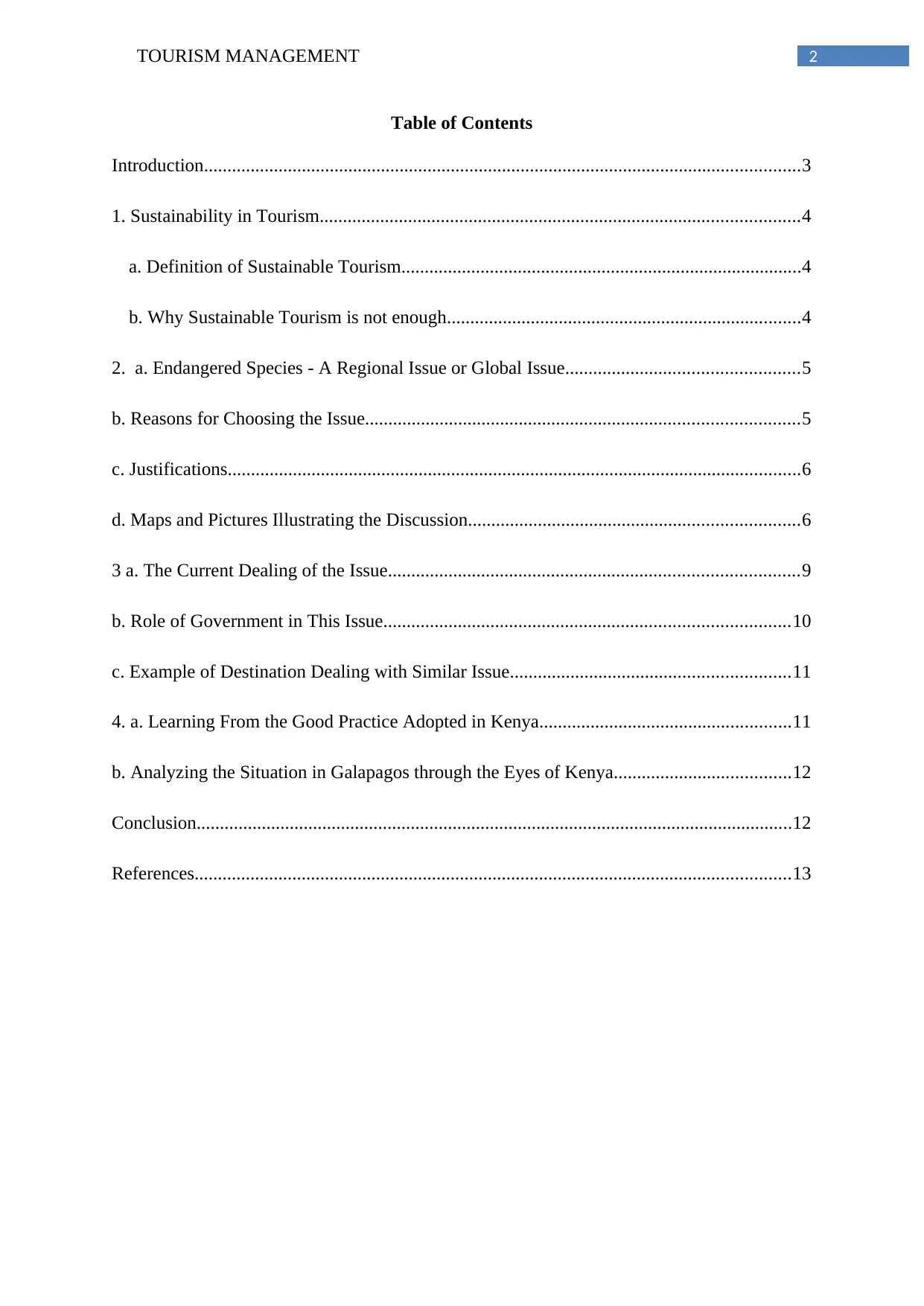
2TOURISM MANAGEMENT
Table of Contents
Introduction................................................................................................................................3
1. Sustainability in Tourism.......................................................................................................4
a. Definition of Sustainable Tourism......................................................................................4
b. Why Sustainable Tourism is not enough............................................................................4
2. a. Endangered Species - A Regional Issue or Global Issue..................................................5
b. Reasons for Choosing the Issue.............................................................................................5
c. Justifications...........................................................................................................................6
d. Maps and Pictures Illustrating the Discussion.......................................................................6
3 a. The Current Dealing of the Issue........................................................................................9
b. Role of Government in This Issue.......................................................................................10
c. Example of Destination Dealing with Similar Issue............................................................11
4. a. Learning From the Good Practice Adopted in Kenya......................................................11
b. Analyzing the Situation in Galapagos through the Eyes of Kenya......................................12
Conclusion................................................................................................................................12
References................................................................................................................................13
Table of Contents
Introduction................................................................................................................................3
1. Sustainability in Tourism.......................................................................................................4
a. Definition of Sustainable Tourism......................................................................................4
b. Why Sustainable Tourism is not enough............................................................................4
2. a. Endangered Species - A Regional Issue or Global Issue..................................................5
b. Reasons for Choosing the Issue.............................................................................................5
c. Justifications...........................................................................................................................6
d. Maps and Pictures Illustrating the Discussion.......................................................................6
3 a. The Current Dealing of the Issue........................................................................................9
b. Role of Government in This Issue.......................................................................................10
c. Example of Destination Dealing with Similar Issue............................................................11
4. a. Learning From the Good Practice Adopted in Kenya......................................................11
b. Analyzing the Situation in Galapagos through the Eyes of Kenya......................................12
Conclusion................................................................................................................................12
References................................................................................................................................13
⊘ This is a preview!⊘
Do you want full access?
Subscribe today to unlock all pages.

Trusted by 1+ million students worldwide
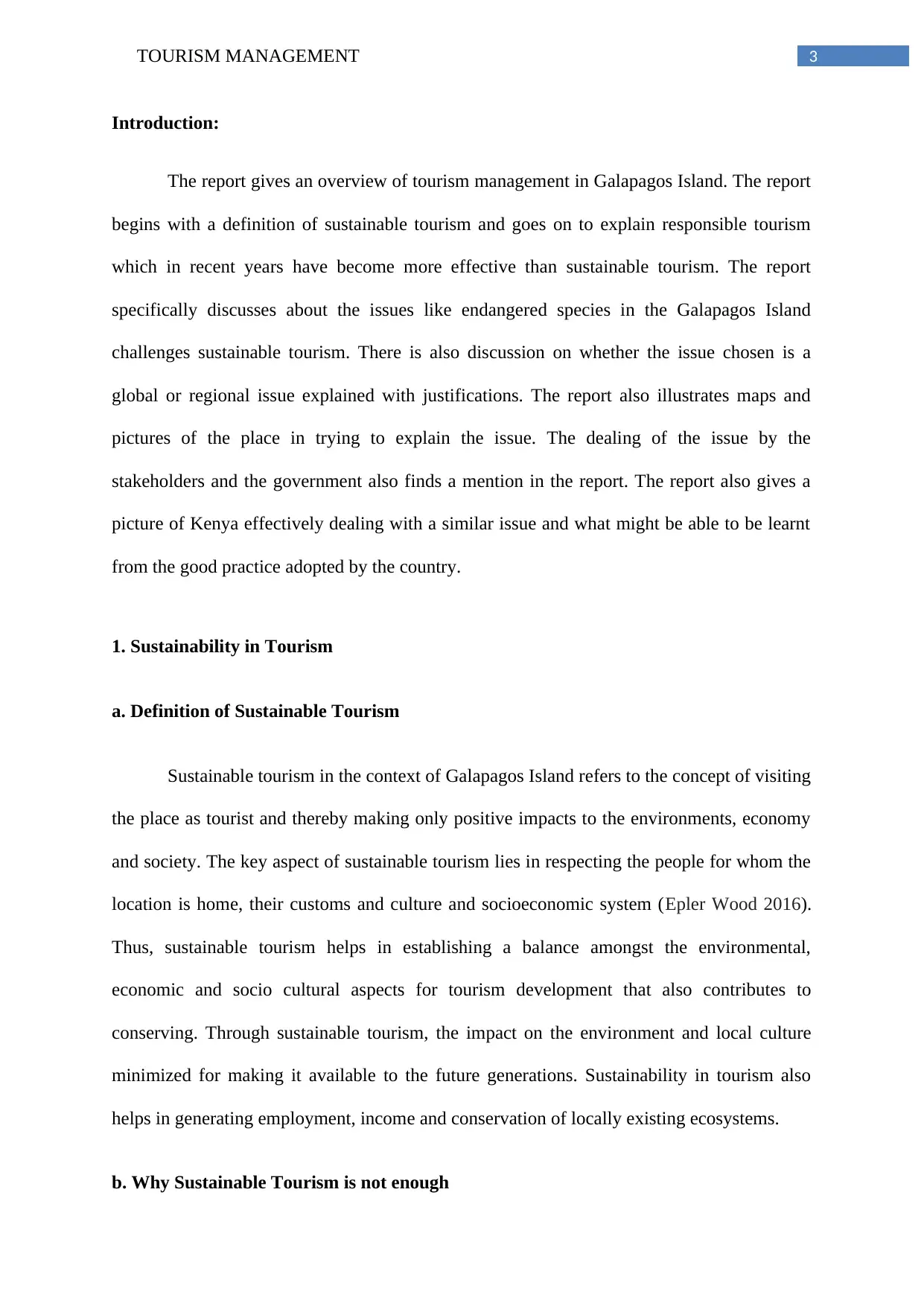
3TOURISM MANAGEMENT
Introduction:
The report gives an overview of tourism management in Galapagos Island. The report
begins with a definition of sustainable tourism and goes on to explain responsible tourism
which in recent years have become more effective than sustainable tourism. The report
specifically discusses about the issues like endangered species in the Galapagos Island
challenges sustainable tourism. There is also discussion on whether the issue chosen is a
global or regional issue explained with justifications. The report also illustrates maps and
pictures of the place in trying to explain the issue. The dealing of the issue by the
stakeholders and the government also finds a mention in the report. The report also gives a
picture of Kenya effectively dealing with a similar issue and what might be able to be learnt
from the good practice adopted by the country.
1. Sustainability in Tourism
a. Definition of Sustainable Tourism
Sustainable tourism in the context of Galapagos Island refers to the concept of visiting
the place as tourist and thereby making only positive impacts to the environments, economy
and society. The key aspect of sustainable tourism lies in respecting the people for whom the
location is home, their customs and culture and socioeconomic system (Epler Wood 2016).
Thus, sustainable tourism helps in establishing a balance amongst the environmental,
economic and socio cultural aspects for tourism development that also contributes to
conserving. Through sustainable tourism, the impact on the environment and local culture
minimized for making it available to the future generations. Sustainability in tourism also
helps in generating employment, income and conservation of locally existing ecosystems.
b. Why Sustainable Tourism is not enough
Introduction:
The report gives an overview of tourism management in Galapagos Island. The report
begins with a definition of sustainable tourism and goes on to explain responsible tourism
which in recent years have become more effective than sustainable tourism. The report
specifically discusses about the issues like endangered species in the Galapagos Island
challenges sustainable tourism. There is also discussion on whether the issue chosen is a
global or regional issue explained with justifications. The report also illustrates maps and
pictures of the place in trying to explain the issue. The dealing of the issue by the
stakeholders and the government also finds a mention in the report. The report also gives a
picture of Kenya effectively dealing with a similar issue and what might be able to be learnt
from the good practice adopted by the country.
1. Sustainability in Tourism
a. Definition of Sustainable Tourism
Sustainable tourism in the context of Galapagos Island refers to the concept of visiting
the place as tourist and thereby making only positive impacts to the environments, economy
and society. The key aspect of sustainable tourism lies in respecting the people for whom the
location is home, their customs and culture and socioeconomic system (Epler Wood 2016).
Thus, sustainable tourism helps in establishing a balance amongst the environmental,
economic and socio cultural aspects for tourism development that also contributes to
conserving. Through sustainable tourism, the impact on the environment and local culture
minimized for making it available to the future generations. Sustainability in tourism also
helps in generating employment, income and conservation of locally existing ecosystems.
b. Why Sustainable Tourism is not enough
Paraphrase This Document
Need a fresh take? Get an instant paraphrase of this document with our AI Paraphraser
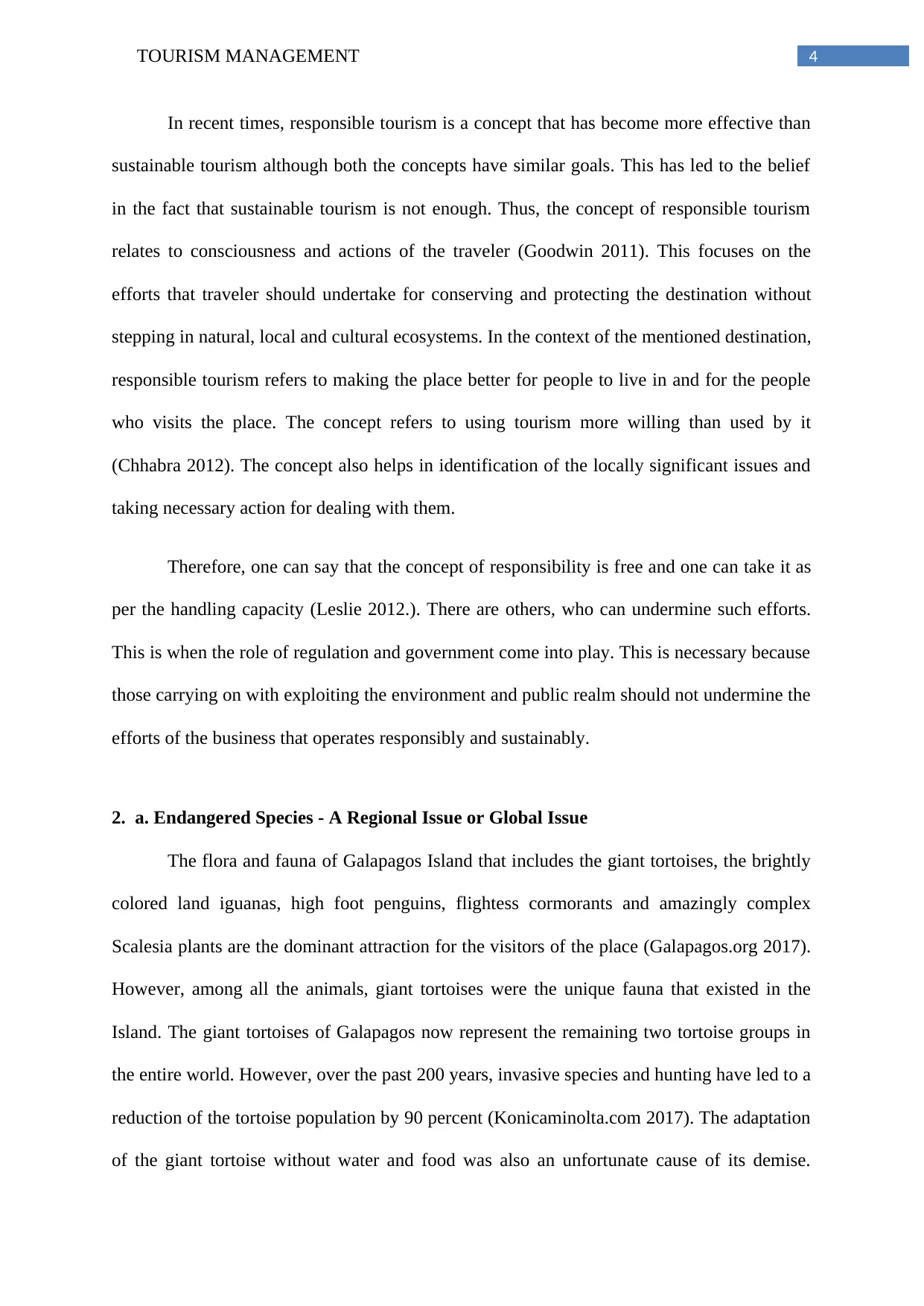
4TOURISM MANAGEMENT
In recent times, responsible tourism is a concept that has become more effective than
sustainable tourism although both the concepts have similar goals. This has led to the belief
in the fact that sustainable tourism is not enough. Thus, the concept of responsible tourism
relates to consciousness and actions of the traveler (Goodwin 2011). This focuses on the
efforts that traveler should undertake for conserving and protecting the destination without
stepping in natural, local and cultural ecosystems. In the context of the mentioned destination,
responsible tourism refers to making the place better for people to live in and for the people
who visits the place. The concept refers to using tourism more willing than used by it
(Chhabra 2012). The concept also helps in identification of the locally significant issues and
taking necessary action for dealing with them.
Therefore, one can say that the concept of responsibility is free and one can take it as
per the handling capacity (Leslie 2012.). There are others, who can undermine such efforts.
This is when the role of regulation and government come into play. This is necessary because
those carrying on with exploiting the environment and public realm should not undermine the
efforts of the business that operates responsibly and sustainably.
2. a. Endangered Species - A Regional Issue or Global Issue
The flora and fauna of Galapagos Island that includes the giant tortoises, the brightly
colored land iguanas, high foot penguins, flightess cormorants and amazingly complex
Scalesia plants are the dominant attraction for the visitors of the place (Galapagos.org 2017).
However, among all the animals, giant tortoises were the unique fauna that existed in the
Island. The giant tortoises of Galapagos now represent the remaining two tortoise groups in
the entire world. However, over the past 200 years, invasive species and hunting have led to a
reduction of the tortoise population by 90 percent (Konicaminolta.com 2017). The adaptation
of the giant tortoise without water and food was also an unfortunate cause of its demise.
In recent times, responsible tourism is a concept that has become more effective than
sustainable tourism although both the concepts have similar goals. This has led to the belief
in the fact that sustainable tourism is not enough. Thus, the concept of responsible tourism
relates to consciousness and actions of the traveler (Goodwin 2011). This focuses on the
efforts that traveler should undertake for conserving and protecting the destination without
stepping in natural, local and cultural ecosystems. In the context of the mentioned destination,
responsible tourism refers to making the place better for people to live in and for the people
who visits the place. The concept refers to using tourism more willing than used by it
(Chhabra 2012). The concept also helps in identification of the locally significant issues and
taking necessary action for dealing with them.
Therefore, one can say that the concept of responsibility is free and one can take it as
per the handling capacity (Leslie 2012.). There are others, who can undermine such efforts.
This is when the role of regulation and government come into play. This is necessary because
those carrying on with exploiting the environment and public realm should not undermine the
efforts of the business that operates responsibly and sustainably.
2. a. Endangered Species - A Regional Issue or Global Issue
The flora and fauna of Galapagos Island that includes the giant tortoises, the brightly
colored land iguanas, high foot penguins, flightess cormorants and amazingly complex
Scalesia plants are the dominant attraction for the visitors of the place (Galapagos.org 2017).
However, among all the animals, giant tortoises were the unique fauna that existed in the
Island. The giant tortoises of Galapagos now represent the remaining two tortoise groups in
the entire world. However, over the past 200 years, invasive species and hunting have led to a
reduction of the tortoise population by 90 percent (Konicaminolta.com 2017). The adaptation
of the giant tortoise without water and food was also an unfortunate cause of its demise.
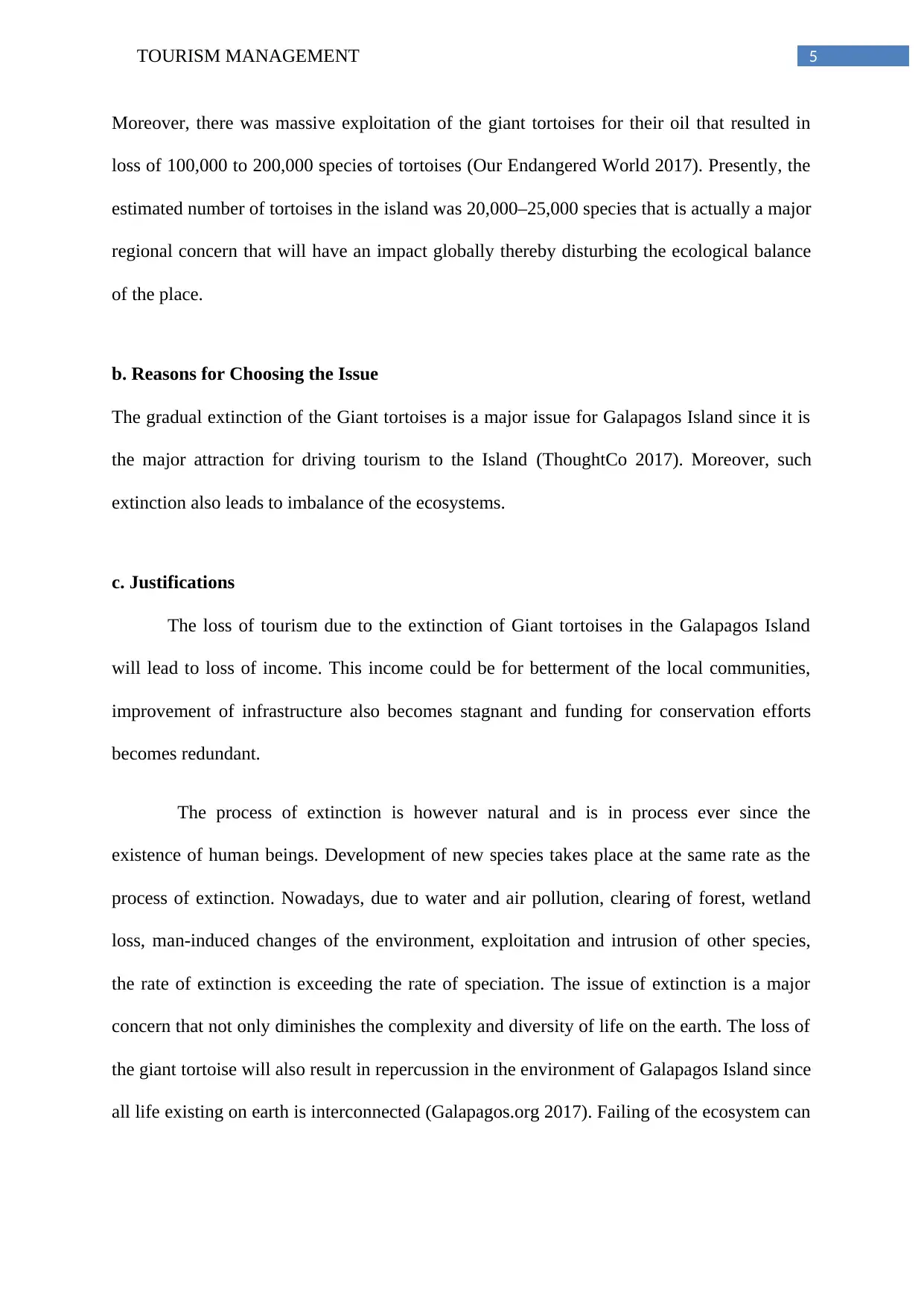
5TOURISM MANAGEMENT
Moreover, there was massive exploitation of the giant tortoises for their oil that resulted in
loss of 100,000 to 200,000 species of tortoises (Our Endangered World 2017). Presently, the
estimated number of tortoises in the island was 20,000–25,000 species that is actually a major
regional concern that will have an impact globally thereby disturbing the ecological balance
of the place.
b. Reasons for Choosing the Issue
The gradual extinction of the Giant tortoises is a major issue for Galapagos Island since it is
the major attraction for driving tourism to the Island (ThoughtCo 2017). Moreover, such
extinction also leads to imbalance of the ecosystems.
c. Justifications
The loss of tourism due to the extinction of Giant tortoises in the Galapagos Island
will lead to loss of income. This income could be for betterment of the local communities,
improvement of infrastructure also becomes stagnant and funding for conservation efforts
becomes redundant.
The process of extinction is however natural and is in process ever since the
existence of human beings. Development of new species takes place at the same rate as the
process of extinction. Nowadays, due to water and air pollution, clearing of forest, wetland
loss, man-induced changes of the environment, exploitation and intrusion of other species,
the rate of extinction is exceeding the rate of speciation. The issue of extinction is a major
concern that not only diminishes the complexity and diversity of life on the earth. The loss of
the giant tortoise will also result in repercussion in the environment of Galapagos Island since
all life existing on earth is interconnected (Galapagos.org 2017). Failing of the ecosystem can
Moreover, there was massive exploitation of the giant tortoises for their oil that resulted in
loss of 100,000 to 200,000 species of tortoises (Our Endangered World 2017). Presently, the
estimated number of tortoises in the island was 20,000–25,000 species that is actually a major
regional concern that will have an impact globally thereby disturbing the ecological balance
of the place.
b. Reasons for Choosing the Issue
The gradual extinction of the Giant tortoises is a major issue for Galapagos Island since it is
the major attraction for driving tourism to the Island (ThoughtCo 2017). Moreover, such
extinction also leads to imbalance of the ecosystems.
c. Justifications
The loss of tourism due to the extinction of Giant tortoises in the Galapagos Island
will lead to loss of income. This income could be for betterment of the local communities,
improvement of infrastructure also becomes stagnant and funding for conservation efforts
becomes redundant.
The process of extinction is however natural and is in process ever since the
existence of human beings. Development of new species takes place at the same rate as the
process of extinction. Nowadays, due to water and air pollution, clearing of forest, wetland
loss, man-induced changes of the environment, exploitation and intrusion of other species,
the rate of extinction is exceeding the rate of speciation. The issue of extinction is a major
concern that not only diminishes the complexity and diversity of life on the earth. The loss of
the giant tortoise will also result in repercussion in the environment of Galapagos Island since
all life existing on earth is interconnected (Galapagos.org 2017). Failing of the ecosystem can
⊘ This is a preview!⊘
Do you want full access?
Subscribe today to unlock all pages.

Trusted by 1+ million students worldwide
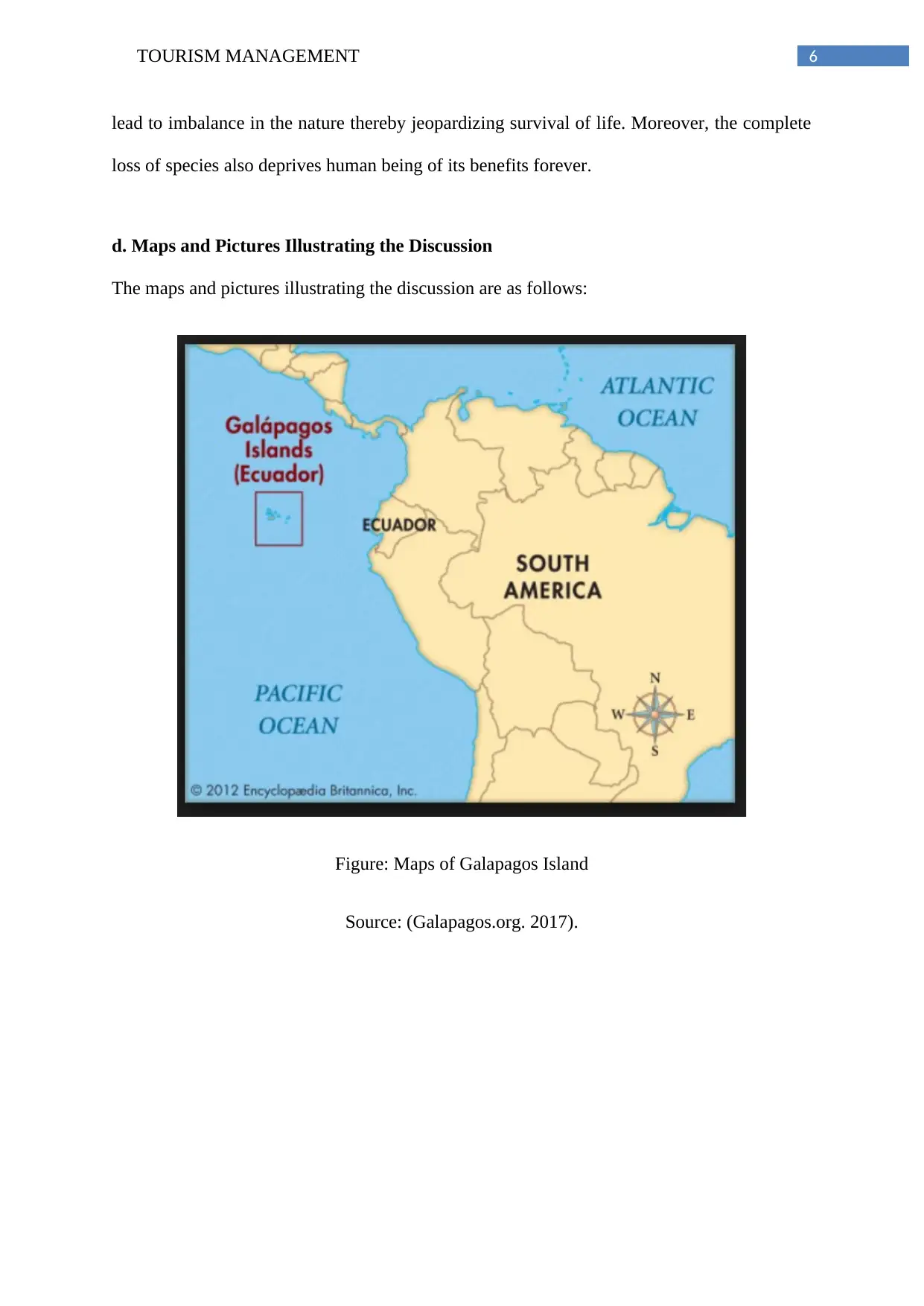
6TOURISM MANAGEMENT
lead to imbalance in the nature thereby jeopardizing survival of life. Moreover, the complete
loss of species also deprives human being of its benefits forever.
d. Maps and Pictures Illustrating the Discussion
The maps and pictures illustrating the discussion are as follows:
Figure: Maps of Galapagos Island
Source: (Galapagos.org. 2017).
lead to imbalance in the nature thereby jeopardizing survival of life. Moreover, the complete
loss of species also deprives human being of its benefits forever.
d. Maps and Pictures Illustrating the Discussion
The maps and pictures illustrating the discussion are as follows:
Figure: Maps of Galapagos Island
Source: (Galapagos.org. 2017).
Paraphrase This Document
Need a fresh take? Get an instant paraphrase of this document with our AI Paraphraser

7TOURISM MANAGEMENT
Figure: Giant Tortoise of Galapagos Island
Source: (ThoughtCo. 2017)
Figure: Giant Tortoise of Galapagos Island
Source: (ThoughtCo. 2017)

8TOURISM MANAGEMENT
Figure: Endangered Giant Tortoise in Galapagos Island
Source: (Our Endangered World 2017).
3 a. The Current Dealing of the Issue
The issue of extinction of a species like giant turtle not only leads to imbalance of the
ecology but also causes lesser drive in tourism (White 2013). Therefore, for rectifying the
situation the Island, the destination management organizations has undertaken measures for
protecting the endangered species. In addition to this, there has been a measure for awareness
creation, complete ban on hunting and other means of exploitation that is responsible for the
extinction of giant species (Barker 2013). Thus, there have been major efforts for restoring
and protecting the endangered species by the various organizations of the Galapagos Island.
In this regard, the Galapagos National Park Directorate (GNPD) and Charles Darwin
Foundation (CDF) since its establishment are making efforts for protecting and enhancing the
Figure: Endangered Giant Tortoise in Galapagos Island
Source: (Our Endangered World 2017).
3 a. The Current Dealing of the Issue
The issue of extinction of a species like giant turtle not only leads to imbalance of the
ecology but also causes lesser drive in tourism (White 2013). Therefore, for rectifying the
situation the Island, the destination management organizations has undertaken measures for
protecting the endangered species. In addition to this, there has been a measure for awareness
creation, complete ban on hunting and other means of exploitation that is responsible for the
extinction of giant species (Barker 2013). Thus, there have been major efforts for restoring
and protecting the endangered species by the various organizations of the Galapagos Island.
In this regard, the Galapagos National Park Directorate (GNPD) and Charles Darwin
Foundation (CDF) since its establishment are making efforts for protecting and enhancing the
⊘ This is a preview!⊘
Do you want full access?
Subscribe today to unlock all pages.

Trusted by 1+ million students worldwide
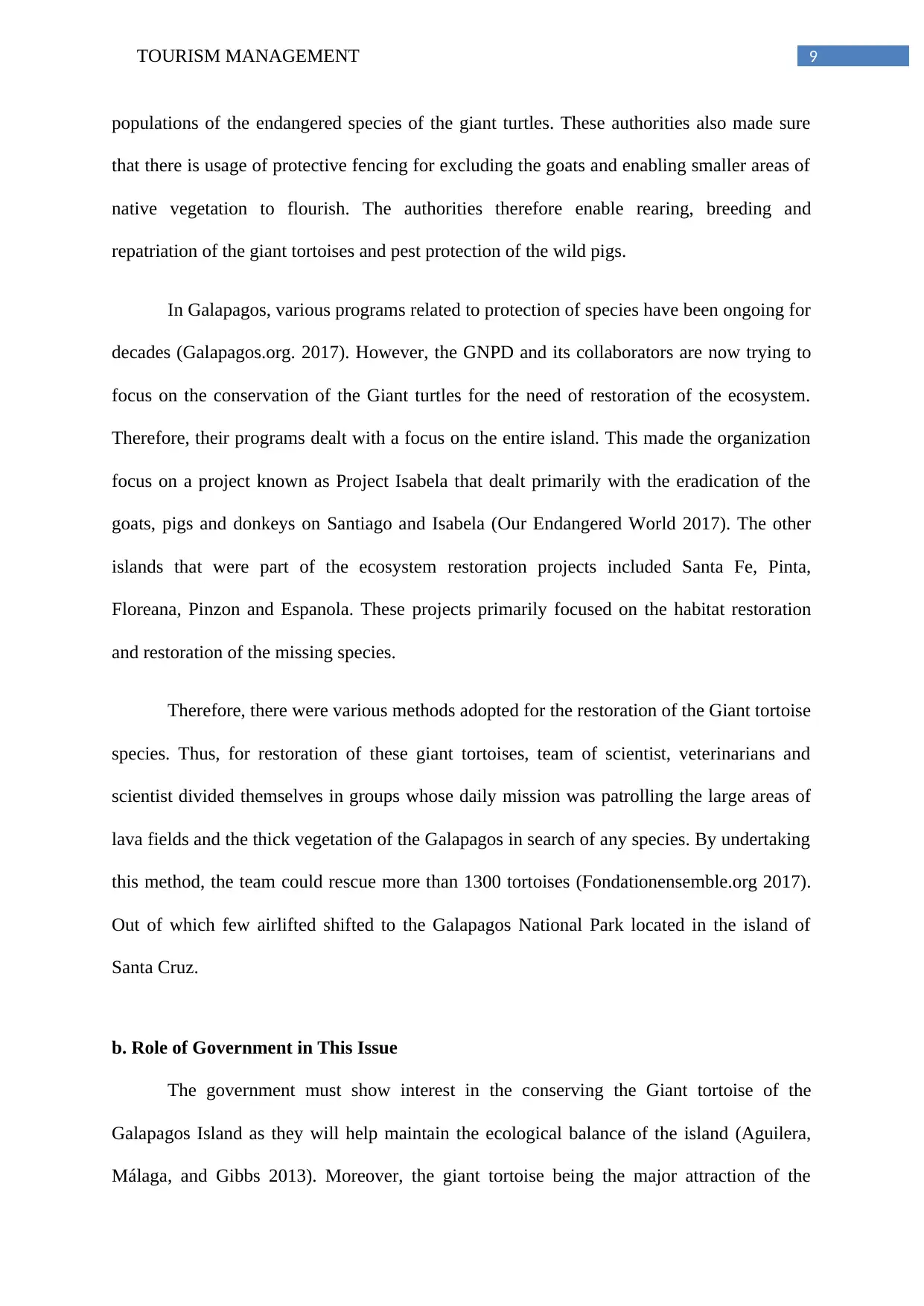
9TOURISM MANAGEMENT
populations of the endangered species of the giant turtles. These authorities also made sure
that there is usage of protective fencing for excluding the goats and enabling smaller areas of
native vegetation to flourish. The authorities therefore enable rearing, breeding and
repatriation of the giant tortoises and pest protection of the wild pigs.
In Galapagos, various programs related to protection of species have been ongoing for
decades (Galapagos.org. 2017). However, the GNPD and its collaborators are now trying to
focus on the conservation of the Giant turtles for the need of restoration of the ecosystem.
Therefore, their programs dealt with a focus on the entire island. This made the organization
focus on a project known as Project Isabela that dealt primarily with the eradication of the
goats, pigs and donkeys on Santiago and Isabela (Our Endangered World 2017). The other
islands that were part of the ecosystem restoration projects included Santa Fe, Pinta,
Floreana, Pinzon and Espanola. These projects primarily focused on the habitat restoration
and restoration of the missing species.
Therefore, there were various methods adopted for the restoration of the Giant tortoise
species. Thus, for restoration of these giant tortoises, team of scientist, veterinarians and
scientist divided themselves in groups whose daily mission was patrolling the large areas of
lava fields and the thick vegetation of the Galapagos in search of any species. By undertaking
this method, the team could rescue more than 1300 tortoises (Fondationensemble.org 2017).
Out of which few airlifted shifted to the Galapagos National Park located in the island of
Santa Cruz.
b. Role of Government in This Issue
The government must show interest in the conserving the Giant tortoise of the
Galapagos Island as they will help maintain the ecological balance of the island (Aguilera,
Málaga, and Gibbs 2013). Moreover, the giant tortoise being the major attraction of the
populations of the endangered species of the giant turtles. These authorities also made sure
that there is usage of protective fencing for excluding the goats and enabling smaller areas of
native vegetation to flourish. The authorities therefore enable rearing, breeding and
repatriation of the giant tortoises and pest protection of the wild pigs.
In Galapagos, various programs related to protection of species have been ongoing for
decades (Galapagos.org. 2017). However, the GNPD and its collaborators are now trying to
focus on the conservation of the Giant turtles for the need of restoration of the ecosystem.
Therefore, their programs dealt with a focus on the entire island. This made the organization
focus on a project known as Project Isabela that dealt primarily with the eradication of the
goats, pigs and donkeys on Santiago and Isabela (Our Endangered World 2017). The other
islands that were part of the ecosystem restoration projects included Santa Fe, Pinta,
Floreana, Pinzon and Espanola. These projects primarily focused on the habitat restoration
and restoration of the missing species.
Therefore, there were various methods adopted for the restoration of the Giant tortoise
species. Thus, for restoration of these giant tortoises, team of scientist, veterinarians and
scientist divided themselves in groups whose daily mission was patrolling the large areas of
lava fields and the thick vegetation of the Galapagos in search of any species. By undertaking
this method, the team could rescue more than 1300 tortoises (Fondationensemble.org 2017).
Out of which few airlifted shifted to the Galapagos National Park located in the island of
Santa Cruz.
b. Role of Government in This Issue
The government must show interest in the conserving the Giant tortoise of the
Galapagos Island as they will help maintain the ecological balance of the island (Aguilera,
Málaga, and Gibbs 2013). Moreover, the giant tortoise being the major attraction of the
Paraphrase This Document
Need a fresh take? Get an instant paraphrase of this document with our AI Paraphraser

10TOURISM MANAGEMENT
Galapagos will also drive in tourism that help in accumulation of funds that can be used for
the development of the various aspects of the Island. Through assistance from the
government, the endangered species of the giant tortoise will have better chances of survival
(Márquez et. al 2013). Thus, the government can provide assistance in the various programs
undertaken the destination authorities for rescuing the Giant tortoise. The government should
implement strict restrictions on any kind of exploitation on the endangered species. More
laws should be in place along with adequate punishment issued for the violation of the law in
causing harm to the endangered species.
c. Example of Destination Dealing with Similar Issue
In this respect one can draw the example of a real world situation of Kenya and how it
protects its endangered species. The crime scenario in Kenya is on the rise which has led to
fall in wildlife. This has also encouraged the Kenya Wildlife Service to step up and take
necessary steps (Karani and Bichanga 2012). The international trade for endangered species
is one of the primary reasons for species becoming extinct and disturbing the ecological
balance. The animals are not only traded for their meat but also used as herbal remedies.
Thus, in order to prevent this extinction and creating an ecological imbalance the Kenyan
Wildlife Service makes used of all traditional tools of enforcement for patrolling the
conservation areas of wildlife, severely penalize wildlife criminals and also stop illegal
hunting. Presently, the service also adopted certain new technologies like the DNA forensic
analysis. Moreover, the Kenyan Wildlife Service launched a Wildlife Enforcement
Monitoring System (WEMS) for tracking regional trans-boundary poachers (Dinerstein et.al
2013). The service has also increased penalties, increased protection in the fields,
strengthened enforcements and raised awareness in public.
Galapagos will also drive in tourism that help in accumulation of funds that can be used for
the development of the various aspects of the Island. Through assistance from the
government, the endangered species of the giant tortoise will have better chances of survival
(Márquez et. al 2013). Thus, the government can provide assistance in the various programs
undertaken the destination authorities for rescuing the Giant tortoise. The government should
implement strict restrictions on any kind of exploitation on the endangered species. More
laws should be in place along with adequate punishment issued for the violation of the law in
causing harm to the endangered species.
c. Example of Destination Dealing with Similar Issue
In this respect one can draw the example of a real world situation of Kenya and how it
protects its endangered species. The crime scenario in Kenya is on the rise which has led to
fall in wildlife. This has also encouraged the Kenya Wildlife Service to step up and take
necessary steps (Karani and Bichanga 2012). The international trade for endangered species
is one of the primary reasons for species becoming extinct and disturbing the ecological
balance. The animals are not only traded for their meat but also used as herbal remedies.
Thus, in order to prevent this extinction and creating an ecological imbalance the Kenyan
Wildlife Service makes used of all traditional tools of enforcement for patrolling the
conservation areas of wildlife, severely penalize wildlife criminals and also stop illegal
hunting. Presently, the service also adopted certain new technologies like the DNA forensic
analysis. Moreover, the Kenyan Wildlife Service launched a Wildlife Enforcement
Monitoring System (WEMS) for tracking regional trans-boundary poachers (Dinerstein et.al
2013). The service has also increased penalties, increased protection in the fields,
strengthened enforcements and raised awareness in public.

11TOURISM MANAGEMENT
4. a. Learning From the Good Practice Adopted in Kenya
However, one can learn from the good practices adopted by Kenya in adopting
measures for protection of its endangered species. The Kenya Wildlife Service (KWS)
ensures providing technical support and training on habitat assessments, translocation and
strategy planning, wildlife health initiatives and management of population (Nurse 2015.).
They have also improved their enforcement law and effectiveness in ecological monitoring
through the use of newer technologies. The service also effectively handles illegal wildlife
trade through a holistic approach.
b. Analyzing the Situation in Galapagos through the Eyes of Kenya
The giant tortoise in Galapagos Island is also facing extinction not only due illegal
activities but also exploitation. Though there are various conservation means ensured by the
development authorities for rescuing the tortoises but they differ somewhat to that of Kenya.
This has to be understood that the difference is due to difference in various aspects of both
the places (Poulakakis et.al 2012). These aspects include governance, culture, power and
wealth. The Galapagos Island however through the establishment of the Charles Darwin
Foundation and the Galapagos National Park ensures the launch of a systematic review on the
present status of the tortoise populations.
Conclusion
The report ends with the analysis of the situation of Galapagos in the light of
measures adopted by Kenya. There is also a discussion on the good practices adopted by
Kenya in protecting its endangered wildlife. The report discusses about the role of the
government in dealing with the issue of endangered species in the Galapagos Island and also
gives a picture about how Kenya deals with the issue. The report also puts forward about how
the issue handled by the various stakeholders along with maps and illustrations. The reasons
4. a. Learning From the Good Practice Adopted in Kenya
However, one can learn from the good practices adopted by Kenya in adopting
measures for protection of its endangered species. The Kenya Wildlife Service (KWS)
ensures providing technical support and training on habitat assessments, translocation and
strategy planning, wildlife health initiatives and management of population (Nurse 2015.).
They have also improved their enforcement law and effectiveness in ecological monitoring
through the use of newer technologies. The service also effectively handles illegal wildlife
trade through a holistic approach.
b. Analyzing the Situation in Galapagos through the Eyes of Kenya
The giant tortoise in Galapagos Island is also facing extinction not only due illegal
activities but also exploitation. Though there are various conservation means ensured by the
development authorities for rescuing the tortoises but they differ somewhat to that of Kenya.
This has to be understood that the difference is due to difference in various aspects of both
the places (Poulakakis et.al 2012). These aspects include governance, culture, power and
wealth. The Galapagos Island however through the establishment of the Charles Darwin
Foundation and the Galapagos National Park ensures the launch of a systematic review on the
present status of the tortoise populations.
Conclusion
The report ends with the analysis of the situation of Galapagos in the light of
measures adopted by Kenya. There is also a discussion on the good practices adopted by
Kenya in protecting its endangered wildlife. The report discusses about the role of the
government in dealing with the issue of endangered species in the Galapagos Island and also
gives a picture about how Kenya deals with the issue. The report also puts forward about how
the issue handled by the various stakeholders along with maps and illustrations. The reasons
⊘ This is a preview!⊘
Do you want full access?
Subscribe today to unlock all pages.

Trusted by 1+ million students worldwide
1 out of 16
Related Documents
Your All-in-One AI-Powered Toolkit for Academic Success.
+13062052269
info@desklib.com
Available 24*7 on WhatsApp / Email
![[object Object]](/_next/static/media/star-bottom.7253800d.svg)
Unlock your academic potential
Copyright © 2020–2025 A2Z Services. All Rights Reserved. Developed and managed by ZUCOL.




